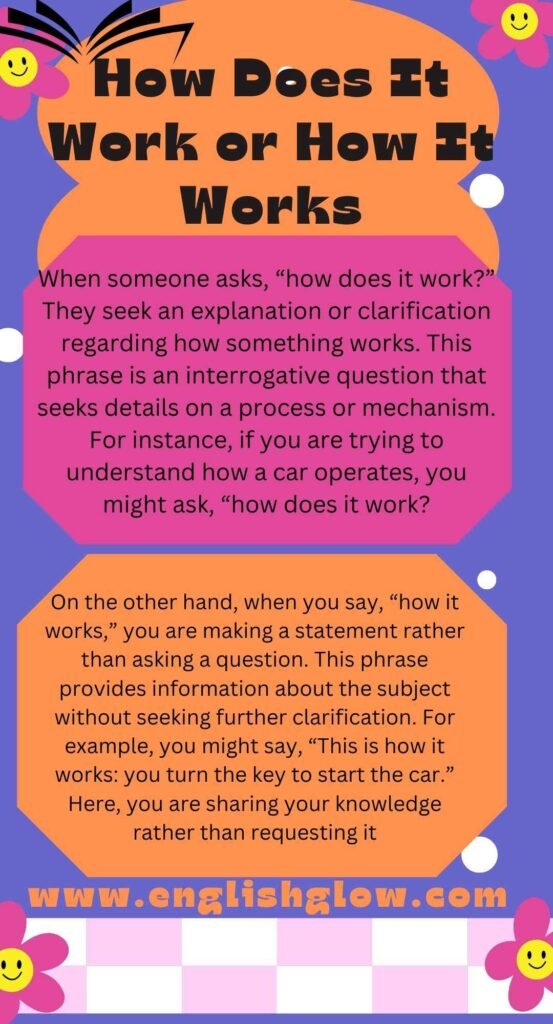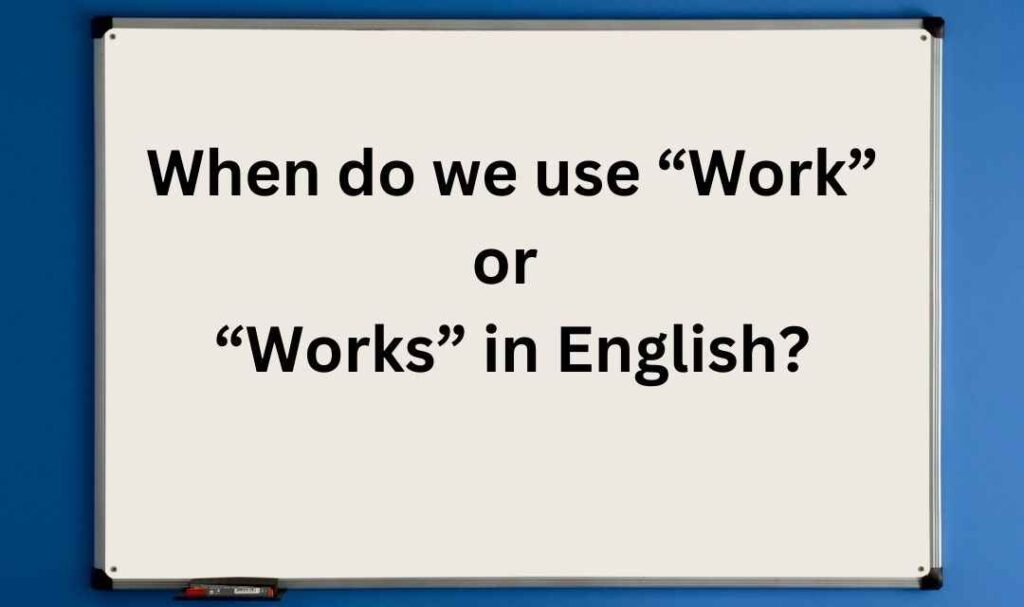The phrases “how does it work” and “how it works” are used in different situations, and knowing when to use each can help improve communication. When you ask “how does it work,” you are making an interrogative sentence. This is a question aimed at seeking clarification or an explanation about the functioning of something. For example, if you are curious about a new app, you might say, “How does it work?” This shows you want to understand how the app functions.
In contrast, “how it works” is used as part of a statement. It provides information rather than asking for it. For instance, you might say, “This is how it works: you click the button to start.” In this case, you are giving an explanation of a concept without posing a question. Understanding the difference helps clarify your intent during conversations.
Example: When discussing a new gadget, you might ask, “How does it work?” to learn more about its features. Conversely, if you already know how to use it, you could explain, “This is how it works: you turn it on, and it starts automatically.” This distinction between asking a question and providing an explanation is essential for effective communication.
What is the meaning of “how does it work”?
When someone asks, “how does it work?” They seek an explanation or clarification regarding how something works. This phrase is an interrogative question that seeks details on a process or mechanism. For instance, if you are trying to understand how a car operates, you might ask, “how does it work?”In this instance, you anticipate the person to describe any unique tricks or features that will enhance your understanding of how it operates.The question encourages a response that provides information, making it clear what you need to know.
On the other hand, when you say, “how it works,” you are making a statement rather than asking a question. This phrase provides information about the subject without seeking further clarification. For example, you might say, “This is how it works: you turn the key to start the car.” Here, you are sharing your knowledge rather than requesting it. Understanding the difference between these two phrases helps improve communication, ensuring that your intent is clear in conversations.
You might enjoy reading:In Summer or In The Summer? Learn the Crucial Difference Today!
When do we use “Work” or “Works” in English?
Knowing when to use “work” or “works” in English is essential for clear communication. The verb “work” is used in its base form, often when we talk about actions in general. For example, you might say, “I work every day.” In this case, you are stating a fact about your routine. On the other hand, “works” is the third-person singular form of the verb and is used when talking about someone else or something that performs the action. For instance, you could say, “She works at a school.” This shows that the subject is doing the action.
Additionally, “work” can also be used as a noun. For example, you might say, “I have a lot of work to do today.” Here, “work” refers to tasks or jobs that need to be completed. When discussing various types of jobs, you might use “works” in a different context, like when referring to multiple pieces of art: “The artist displayed several works of art at the conference.” This highlights that “works” can be a plural noun that describes different creations or projects.
Example: If you are explaining how a project is done, you might say, “This is how it works: we start with planning, then move to execution.” In contrast, if someone asks, “How does it work?” they are looking for an explanation about the process itself. Understanding these distinctions between “work” and “works” helps us express our thoughts more accurately in both spoken and written English.
you might enjoy reading: Too Short or To Short? Discover the Common Mistake You’re Likely Making!
Why people ask “how it works” but not “how it work”?
People often ask, “How it works” instead of “how it work” because of grammar rules in English. When someone asks, “how it works,” they are making a statement rather than a question. The proper phrase employs the third-person singular form of the verb “work,” which is “works.” For example, if you are describing a device to someone, you might say, “This is how it works.” This approach allows you to deliver clear information..
On the other hand, “how does it work” is the proper way to ask for an explanation about the mechanics of something. This is an interrogative sentence that seeks clarification. For example, you might ask, “How does it work?” when you wish to grasp how a machine functions. In this case, you are looking for a detailed answer.
Example
If a family member is confused about how a new phone functions, they might say, “How does it work?” But if you already know how to use the phone, you could respond, “This is how it works: you swipe left to unlock.” This shows the difference between asking for clarification and providing an explanation.
FAQ
Is “how it works” grammatically correct?
Yes, “how it works” is grammatically correct. It is a statement that explains the way something functions or operates. For example, “This is how it works.”
Does it work, or is it works?
The correct phrase is “Does it work?” When forming a question in English, the verb “do/does” is used with the base form of the verb, in this case, “work.” “Is it works” is incorrect because “is” should be followed by a present participle (verb ending in -ing) or an adjective.
Why it works vs. How it works?
“Why it works” explains the reason or cause for something functioning. It focuses on the logic or rationale. “How it works” explains the method or process of something operating. It focuses on the way something functions. For example:
“Why it works: The engine uses a simple combustion process.”
How it works: The engine converts fuel into mechanical energy.”
What is the difference between “how it works” and “how does it work”?
“How it works” is a statement that explains the operation or function of something. “How does it work?” is a question asking for an explanation. The first is a declarative sentence, while the second is an interrogative sentence.
Example
Statement: “This is how it works.”
Question: “How does it work?”
How does it work or how it works?
Both phrases are correct, but they are used in different contexts. “How does it work?” is a question asking for an explanation, while “How it works” is a statement or title summarizing how something functions.
How does it work vs. how it works: What’s the difference?
“How does it work?” is a direct question used when you’re asking someone to explain a process. On the other hand, “How it works” is used to describe or explain the process, often in a non-question format, such as in presentations or articles.
How it work or how it works: Which is correct?
“How it works” is correct. “How it work” is grammatically incorrect because “work” should agree with the subject “it,” which requires the verb “works” in the present tense.
How does it work or how does it works: Which is correct?
“How does it work?” is the correct form. Adding an “s” to “work” after “does” is incorrect because “does” already carries the tense, and the verb should remain in its base form (“work”).
How does it work?
“How does it work?” is a common question used to ask for an explanation about how something functions or operates. For example, “How does this device work?”
How does it work or how it works in a sentence: Which should I use?
Use “How does it work?” when forming a question, and use “How it works” when you are making a statement or explanation.
Example
Question: “How does it work?”
Statement: “Let me explain how it works.”




